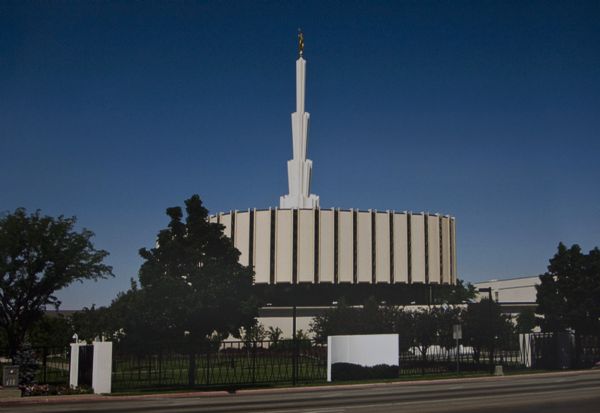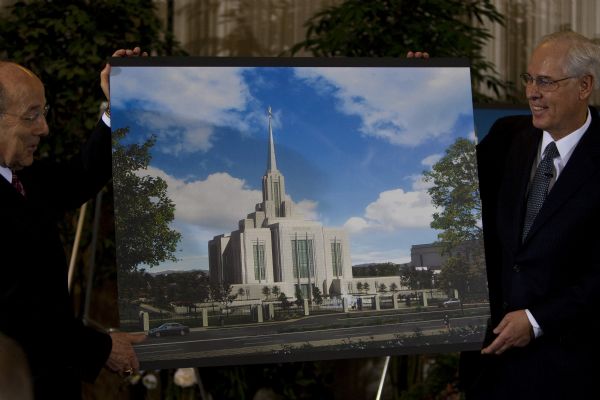This is an archived article that was published on sltrib.com in 2010, and information in the article may be outdated. It is provided only for personal research purposes and may not be reprinted.
Ogden » Downtown Ogden's LDS temple, a rounded building of white cast stone, is getting an extreme makeover. And, when it's finished, the 38-year-old sacred edifice will look a lot like its contemporary counterpart in Draper.
The temple's entire exterior will be reshaped with new stone and art glass and its entrance moved to face Washington Boulevard, rather than the parking lot. The old two-tiered parking garage will be removed and new underground parking added.
The temple's footprint, or core, will remain the same and the space inside will be reconfigured only slightly. Landscaping will be updated, and a water feature and drive-through drop-off will be installed at the front.
LDS officials declined to disclose the project's price tag. But general authority William R. Walker, at a Wednesday news conference, called it a "huge investment."
"It basically is the same as building a new temple," said Walker, a member of the church's First Quorum of the Seventy.
The three members of the church's governing First Presidency decided to update the temple, he added, because "they thought it somewhat dated."
The Ogden Temple -- the church's fifth in Utah and the first post-pioneer-era one in the state -- was dedicated in 1972 by then-LDS President Joseph Fielding Smith.
A sister structure with a similar design was built the same year in Provo but the church has no plans to redo the Provo Temple's exterior, Walker said. He noted the Provo structure is in a different setting (on a hill) and not part of a redeveloping downtown.
Designed by church architect Emil Fetzer, who died in November, the Ogden Temple's look was controversial from the beginning, said Paul Anderson, a Mormon architect who has written much about the faith's historic buildings.
"It was the church's first try at a new kind of temple," Anderson said. "But people found it uncomfortably unfamiliar."
Some of the building materials were associated with commercial, not sacred architecture, he said. And the location on a main city street, rather than elevated above it, added to that impression.
The temple's upper part seemed to float above the lower story on a row of mirrored windows, rather than all the pieces being firmly rooted to one another, Anderson said. That made the temple appear "less grand, permanent or monumental."
Fetzer's interior, though, featured an innovation that has since become a standard in the church. Ordinance rooms -- where Mormons hear the story of human history from the Garden of Eden through mortality to the afterlife -- all lead to the celestial room, representing heaven, in the center.
In 2002, an iconic Angel Moroni statue was added to the temple's spire.
The recent redevelopment of Ogden, which has upgraded 80 acres downtown and has plans to redo 140 acres more, didn't drive the church's decision to overhaul the temple, Walker said, but "the First Presidency felt very good about it."
So does Ogden Mayor Matthew Godfrey.
"This is like Christmas for a mayor," said Godfrey, a former LDS bishop. "Thank you for this demonstration of belief in us."
As Ogden's downtown declined during recent decades, the temple, he said, "has been a symbol of hope and beauty."
It is the single biggest attraction, drawing devout Mormons from a large swath of northern Utah and western Wyoming, including Evanston, Godfrey said. The renovated temple will remain downtown's visual centerpiece, and the mayor expects nearby businesses -- including those expected in the planned Ogden River Project -- to thrive as more weddings are scheduled in the updated edifice.
At the news conference, Bishop Keith B. McMullin of the church's Presiding Bishopric reiterated the faith's commitment to that effort. The city block that holds the temple and a neighboring tabernacle is flanked on three sides by church-owned property. The church's real-estate arm has built nearly 300 apartments, Colonial Court, to the west and north in the past decade, including some units that are just going on the market.
McMullin said there is no timetable for developing the rest of the block north of the temple, although he expects it eventually to involve more housing and an office building, Ensign Plaza-North, to match Ensign Plaza-South, which the church put up south of the temple three years ago.
"People want to live downtown," he said, "and they want to live near the temple."
Last October, the church announced plans for a new temple in Brigham City, partly to lighten Ogden's load. (Last month, the faith also said it will build a temple in Payson, the 15th in Utah.)
The Ogden Temple serves more than 70 stakes and nearly 265,000 Mormons. No timetable for the reconstruction is set yet, although the temple could be closed later this year or early next year, Walker said. During the overhaul, members can attend the Logan or Bountiful temples.
One casualty of the temple's remake, though, will be the steeple on the adjacent tabernacle, a modern structure of steel and concrete built in the 1950s. The First Presidency wanted that steeple removed, Walker said, "so that the focus is clearly on the temple."
Howard Pluim, an LDS bishop in inner-city Ogden, had not heard Wednesday afternoon of the temple remake, but said "anything they do to downtown is good."
But he was withholding judgment about the temple's face-lift.
"It was my temple since I was 12 years old," Pluim said. "I'll miss the look."
pstack@sltrib.com" Target="_BLANK">pstack@sltrib.com
kmoulton@sltrib.com" Target="_BLANK">kmoulton@sltrib.com
Size » 131,000 square feet.
Announced » Aug. 24, 1967.
Dedicated » Jan. 18-20, 1972 by President Joseph Fielding Smith.
Architect » Emil Fetzer.
Contractor » Okland Construction Co.
Rooms » Baptistry, celestial room, six ordinance rooms, 11 sealing rooms, four floors.
Source: Deseret News 2010 Church News Almanac
Brigham City (announced)
Bountiful
Draper
Jordan River (South Jordan)
Logan
Manti
Monticello
Mount Timpanogos (American Fork)
Ogden (to be overhauled)
Oquirrh Mountain (South Jordan)
Payson (announced)
Provo
St. George
Salt Lake City
Vernal
Source: LDS Church





